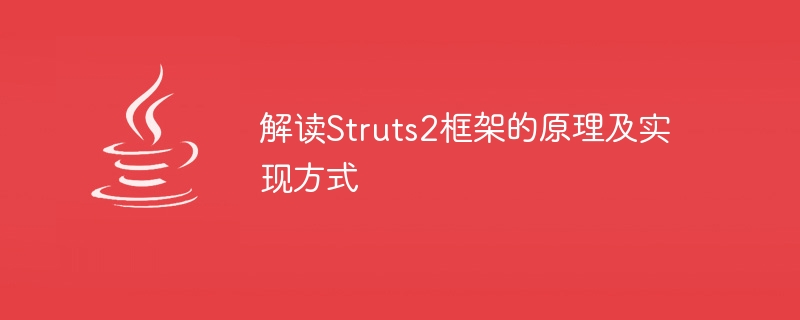Home >Java >javaTutorial >In-depth analysis of the working principle and implementation of the Struts2 framework
In-depth analysis of the working principle and implementation of the Struts2 framework
- WBOYWBOYWBOYWBOYWBOYWBOYWBOYWBOYWBOYWBOYWBOYWBOYWBOriginal
- 2024-01-05 16:08:19872browse

Interpretation of the principles and implementation methods of the Struts2 framework
Introduction:
Struts2, as a popular MVC (Model-View-Controller) framework, is widely used in Java Web Development. It provides a way to separate the web layer from the business logic layer and is flexible and scalable. This article will introduce the basic principles and implementation methods of the Struts2 framework, and provide some specific code examples to help readers better understand the framework.
1. Framework principle:
The basic principle of Struts2 is to use a central controller (ActionServlet) to be responsible for the distribution and processing of requests. When a user sends an HTTP request, the framework maps the request URL to the corresponding Action class and calls the corresponding method to handle the request.
In Struts2, Action is the core component for processing requests. It is an ordinary Java class that is responsible for receiving request parameters, processing business logic, and returning a result page after execution. Usually, an Action class corresponds to a URL path and can receive and return various types of data.
During the execution process, the Struts2 framework implements various functions through interceptors (Interceptor). The interceptor is a pluggable component that can perform some common logic before and after the request, such as logging, permission verification, etc. At the same time, the Struts2 framework also provides the concept of an interceptor stack. Developers can configure different interceptor stacks to achieve a combination of various functions.
2. Framework implementation method:
- Configuration file:
The configuration files of Struts2 mainly include struts.xml and web.xml. Among them, struts.xml is the core configuration file of the framework, which defines various components, interceptor stacks, and mapping relationships between URLs and Actions. web.xml is the deployment description file of the Web application, which is used to configure the ActionServlet of Struts2 and some parameters related to the framework. - Action class:
The Action class is the core component of the Struts2 framework. It defines methods for processing requests by inheriting or implementing the corresponding interface. In these methods, developers can obtain request parameters, perform business logic processing, and return a result page.
The following is a simple Action class example:
public class LoginAction implements Action {
private String username;
private String password;
public String execute() {
// 处理登录逻辑
if (username.equals("admin") && password.equals("123456")) {
return "success";
} else {
return "error";
}
}
// 根据参数名自动注入值
public void setUsername(String username) {
this.username = username;
}
public void setPassword(String password) {
this.password = password;
}
}- View:
In Struts2, views are usually implemented using JSP (JavaServer Pages). Developers can specify the location of the result view by returning a string in the Action method, and the framework will automatically pass the result to the corresponding JSP file for rendering.
The following is a simple JSP view example:
<%@ page language="java" contentType="text/html; charset=UTF-8" pageEncoding="UTF-8"%>
<!DOCTYPE html>
<html>
<head>
<title>Login Result</title>
</head>
<body>
<h1>Login Result:</h1>
<%
String result = (String) request.getAttribute("struts.result");
if (result.equals("success")) {
out.println("Login success!");
} else {
out.println("Login failed!");
}
%>
</body>
</html>Conclusion:
The principles and implementation of the Struts2 framework can to a certain extent help developers better understand and Apply this framework. By properly configuring and using interceptors, action classes, and views, developers can quickly build web applications that meet business needs.
However, this article only briefly introduces the principles and implementation methods of the Struts2 framework, and does not discuss its internal implementation mechanism in depth. If readers want to have a deeper understanding of the framework, it is recommended to refer to relevant official documents and materials, or refer to open source code for research.
The above is the detailed content of In-depth analysis of the working principle and implementation of the Struts2 framework. For more information, please follow other related articles on the PHP Chinese website!

